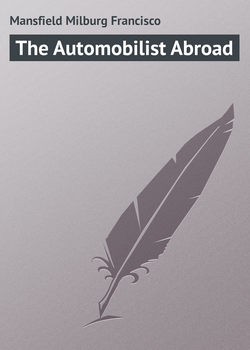Читать книгу The Automobilist Abroad - Mansfield Milburg Francisco - Страница 5
Part I
General Information – The Grand Tour
Chapter V
The Grand Tour
ОглавлениеThe advantages of touring by automobile are many: to see the country, to travel agreeably, to be independent of railways, and to be an opportunist – that is to say to be able to fly off at a tangent of fifty or a hundred kilometres at a moment's notice, in order to take in some fête or fair, or celebration or pilgrimage.
"Le tourisme en automobile" is growing all over the world, but after all it is generally only in or near the great cities and towns that one meets an automobile on the road. They hug the great towns and their neighbouring resorts with astonishing persistency. Of the one thousand automobiles at Nice in the season it is certain that nine-tenths of the number that leave their garages during the day will be found sooner or later on the famous "Corniche," going or coming from Monte Carlo, instead of discovering new tracks for themselves in the charming background of the foot-hills of the Maritime Alps.
In England, too, the case is not so very different. There are a thousand "week-enders" in automobiles on the way to Brighton, Southsea, Bournemouth, Scarborough, or Blackpool to ten genuine tourists, and this even though England and Wales and Scotland form a snug little touring-grounds with roads nearly, if not always, excellent, and with accommodations – of a sort – always close at hand.
In Germany there seems to be more genuine touring, in proportion to the number of automobiles in use, than elsewhere. This may not prove to be wholly the case, as the author judges only from his observations made on well-worn roads.
Switzerland is either all touring, or not at all; it is difficult to decide which. At any rate most of the strangers within its frontiers are tourists, and most of the tourists are strangers, and many of them take their automobiles with them in spite of the "feeling" lately exhibited there against stranger automobilists.
Belgium and Holland, as touring-grounds for automobilists, do not figure to any extent. This is principally from the fact that they are usually, so far as foreign automobilists are concerned, included in more comprehensive itineraries. They might be known more intimately, to the profit of all who pass through them. They are distinctly countries for leisurely travel, for their areas are so restricted that the automobilist who covers two or three hundred kilometres in the day will hardly remember that he has passed through them.
Northern Italy forms very nearly as good a touring-ground as France, and the Italian engineers have so refined the automobile of native make, and have so fostered automobilism, that accommodations are everywhere good, and the tourist to-day will not lack for supplies of benzina and olio as he did a few years ago.
The bulk of the automobile traffic between France and Italy enters through the gateway of the Riviera, and, taken all in all, this is by far the easiest, and perhaps the most picturesque, of routes. Alternatives are through Gap and Cuneo, Briançon and Susa, Moutiers and Aosta, or by the Swiss passes, the latter perhaps the most romantic of routes in spite of their difficulties and other objections.
